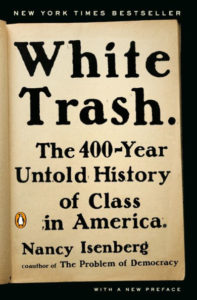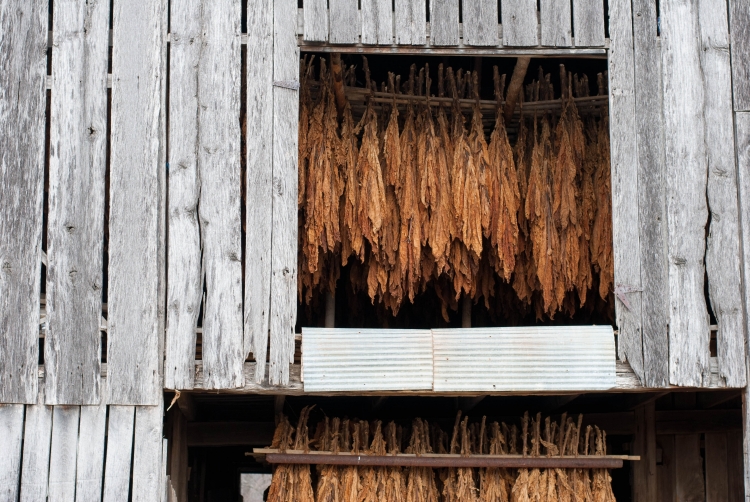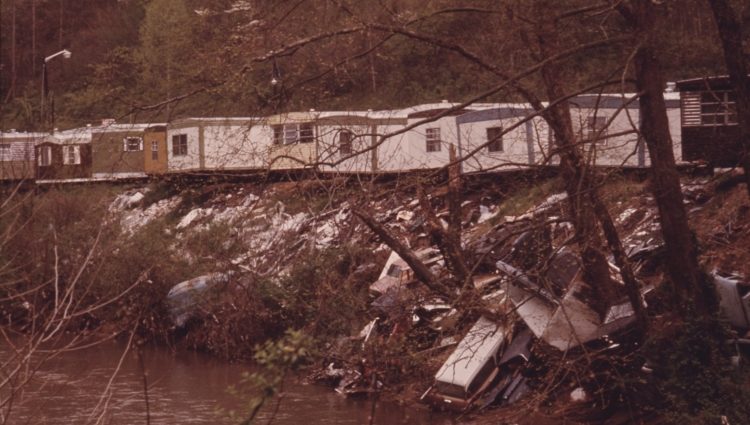 White trash have been with us since colonial times – though they often went by other names. That’s the contention of historian Nancy Isenberg in White Trash: The 400-Year Untold History of Class in America. Isenberg also destroys assumptions about America’s allegedly class-free society in which all one needed were liberty and hard work to ensure genuine social mobility. In her preface, Isenberg offers a sweeping assessment of the ubiquity of poor whites as an expendable, bottom layer of society:
White trash have been with us since colonial times – though they often went by other names. That’s the contention of historian Nancy Isenberg in White Trash: The 400-Year Untold History of Class in America. Isenberg also destroys assumptions about America’s allegedly class-free society in which all one needed were liberty and hard work to ensure genuine social mobility. In her preface, Isenberg offers a sweeping assessment of the ubiquity of poor whites as an expendable, bottom layer of society:
The poor, the waste, the rubbish, as they are variously labeled, have stood front and center during America’s most formative political contests. During colonial settlement, they were useful pawns as well as rebellious troublemakers, a pattern that persisted amid mass migrations of landless squatters westward across the continent. Southern poor whites figured prominently in the rise of Abraham Lincoln’s Republican Party, and in the atmosphere of distrust that caused bad blood to percolate among the poorer classes within the Confederacy during the Civil War. White trash were dangerous outliers in efforts to rebuild the Union during Reconstruction; and in the first two decades of the twentieth century, when the eugenics movement flourished, they were the class of degenerates targeted for sterilization (xxvii).
The author also recognizes the absurdity of discussing class as distinct from race: “Of course the intersection of race and class remains an undeniable part of the overall story” (xviii).
Isenberg begins at the beginning with the first permanent English settlement at Jamestown, Virginia, in 1607. From the start, colonial settlers fabricated aristocratic connections nurturing a sense of entitlement that provided obstacles to easy settlement and economic productivity. Students of the period will recall John Smith’s complaint that Jamestown’s early denizens contained too many gentlemen and too few workers. Without people willing to till the soil, the Jamestown experiment devolved into chaos, as Isenberg describes:
Social mores were nonexistent. Men defecated in public areas within the small garrison. People sat around and starved. Harsh laws were imposed: stealing vegetables and blasphemy were punishable by death. Laborers and their children were virtual commodities, effectively slaves. One man murdered his wife and then ate her (24).
Class consciousness in America was born on Virginia’s shores. Another wave of colonists arrived in 1611, describing how their predecessors wallowed in “sluggish idleness” and “bestial sloth.” Ironically, the habits displayed by Jamestown citizenry would later be characterized as “white trash” behavior. Fortunately for the Virginia settlers, native peoples supplied the answer to Jamestown’s problems: tobacco. Whereas before, a favorite pastime of Jamestown men was raping Indian women, now the marriage of John Rolfe and Pocahontas ensured mutual cooperation and economic prosperity. However, as Isenberg notes, “Tobacco was at once both a boom and a bane. Though it saved the colony from ruin, it stunted the economy and generated a skewed class system” (25).

The governor of the colony responded to unprecedented demand for tobacco by enlisting England to send over white indentured servants who were sold to the highest bidder and who were, as Isenberg tells us, “hoarded, overworked, and their terms unfairly extended” (26). As petitions for laborers increased, the wealthy class of planters in Jamestown sought to locate untapped reserves of manual labor. They and their self-styled aristocratic cousins in Georgia petitioned for slaves. Isenberg discussed the rationale of planters proposing this solution:
[Plantations thought that] Negroes were “bred up” for hard labor in the same way as sailors. Africans would survive in damp, noxious swamps as well as in the sweltering heat. They were cheap to feed and clothe. A meager subsistence diet of water, corn, and potatoes was thought adequate to keep them alive and active. One outfit and a single pair of shoes would last an entire year. White indentured servants were fundamentally different. They demanded English dress for every season. They expected meat, bread, and beer on the table, and if denied this rich diet felt languid and feeble and would refuse to work (59).
Isenberg avers that a classless society was never the intent of the Colonial and Revolutionary Fathers. In fact, Thomas Jefferson was one of America’s first eugenicists, formulating theories about the breeding of slaves, in one circumstance. In another case, he described a model of breeding that would generate an “accidental aristocracy” of talent required for America’s new experiment in government:
Class divisions would form through natural selection. Men would marry women for more than money; they would consciously and unconsciously choose mates with other favorable traits. It was all a matter of probability: some would marry out of sheer lust, others for property, but the “good and wise” would marry for beauty, health, virtue, and talents. If Americans had enough native intelligence to distinguish the natural aristoi from the pseudo-aristoi in choosing political leaders, then they had reasonable instincts for selecting spouses. A ‘fortuitous concourse of breeders’ would produce a leadership class – one that would sort out the genuinely talented from the ambitious men on the make .
The question that Jefferson never answered was this: What happened to those who were not part of the talented elite? How would one describe the ‘concourse of breeders’ living on the bottom layer of society? No matter how one finessed it, rubbish produced more rubbish, even if a select few might be salvaged. If the fortuitous breeders naturally rose up the social ladder, the unfortunate, the degenerate remained mired in the morass of meaner sorts (102).
Unfortunately, Jefferson and his peers in government were obsessed with the highest tier of society while evincing little or no concern for those living at the bottom layer of a system predicated on wealth, privilege, and “pure stock.” By the nineteenth century, a new vocabulary arose describing this class of individuals as “the scum of nature,” “vermin,” and “white trash,” first appearing in print in 1821. Lines of geographical demarcation delimited the whereabouts of this pestilential population. Not surprisingly, most resided in the South. The author of White Trash explains:
White trash southerners were classified as a “race” that passed on horrific traits, eliminating any possibility of improvement or social mobility. If these Night of the Living Dead qualities were not enough, critics charged that poor whites had fallen below African slaves on the scale of humanity. They marked an evolutionary decline, and they foretold a dire future for the Old South. If free whites produced feeble children, how could a robust democracy thrive? If whiteness was not an automatic badge of superiority, a guarantee of the homogenous population of independent, educable freemen, as Jefferson imagined, then the ideals of life, liberty, and the pursuit of happiness were unobtainable (136).
The Civil War and its aftermath intensified the hostility poor whites had toward Black freedmen. The rise of the Ku Klux Klan was an effort to re-establish the supremacy of white planters dispossessed by Reconstruction legislation. However, when elements of the rural white underworld swelled the ranks of the Klan, Klan founder Nathan Bedford Forrest disbanded the organization in 1868, declaring that it had become too violent, calling it “the worst mistake our people ever made.” Apparently even Forrest recognized the growing dangers posed by “white trash.”
Not until the twentieth century and in the throes of the Great Depression did someone take the plight of poor whites seriously. That individual was Knoxville, Tennessee, native, James Agee. In 1936, the Harvard educated author, along with photographer Walker Evans, traveled to rural Hale County, Alabama, to document the plight of poor sharecroppers there. Agee and Evans lived with their subjects for eight weeks. Together, the collaborators produced the stunning Let Us Now Praise Famous Men, an oratorio of sorts designed to call attention to people desperately ignored to the point of being invisible. Isenberg describes Agee’s anxiety in undertaking the project and receiving pay from Forbes magazine:
Agee opened the book by wondering out loud how a Harvard educated, middle-class man like himself could write about poor whites without turning them into objects of pity or disgust. He did not want to be a mere gawker. How could he “pry intimately into the lives of an undefended and appallingly damaged group of human beings, an ignorant and helpless rural family, for the purpose of parading the nakedness, disadvantage and humiliation of these lives before another group of human beings, in the name of science, of ‘honest journalism’”? Was it possible to convey the “cruel radiance of what is”? Probably not (227).
Yet Agee arrived at some conclusions that flew in the face of popular prejudices, as Isenberg notes:
In this strangely introspective, deeply disturbing narrative, the author tries to force readers to look beyond conventional ways of seeing the poor. Instead of blaming them, he asks his audience to acknowledge their own complicity. The poor are not dull or slow-witted, he insists; they have merely internalized a kind of “anesthesia,” which numbs them against the “shame and insult of discomforts, insecurities, and inferiorities.” The southern middle class deserves the greater portion of shame, and especially those who excused their own callous indifference with the line, “They are ‘used’ to it” (228).
Agee’s exposé had political implications in subsequent decades. In the fashion of FDR, Presidents Kennedy and Johnson both understood the capital that this population represented. In private, neither man was always kind to poor rural whites. However, LBJ, always the consummate politico, secured passage of the Appalachian Regional Development Act, and battling rural poverty remained a critical plank of Johnson’s “War on Poverty.” Johnson’s appeal to this block of voters was an ironic counterpoint to the country’s middle class and ruling elites. Johnson could be a bottom feeder – as coarse, crass, and “trashy” as his constituents. In fact, Johnson gave license to lower-class behaviors.
Later Southern presidents didn’t always clean up well, either. In a now famous Playboy interview, Jimmy Carter admitted to lusting in his heart while expressing chagrin at his redneck brother’s beer-guzzling antics. Nor did it escape anyone’s notice that Bill Clinton’s sexual philanderings all but destroyed his presidency. The Arkansas native’s easy deceptions and gift of gab earned him the nickname “Slick Willy.”
In her preface to White Trash, Nancy Isenberg places Donald Trump in a historical succession of politicians pandering to “forgotten Americans.” Trump joins the ranks of an illustrious gallery of rogues: Andrew Jackson, Davy Crockett, John Randolph of Roanoke, Teddy Roosevelt, George Wallace, and Ross Perot. Trump is right at home with his confreres, as Isenberg’s nuanced historical insights attest:
Trump’s antics mirror this long tradition. One of his campaign managers, Paul Manafort, admitted at one point that Trump was simply “projecting an image.” Who’s surprised? Americans have a taste for a “democracy of manners,” which is different from real democracy. Voters accept huge disparities in wealth, while expecting their elected leaders to appear to be no different from the rest of us. By talking tough, by boasting that he’d love to throw a punch at a protester, candidate Trump pretended he was stepping down from his opulent Manhattan penthouse to commingle with the unwashed masses. Wearing his not-so-classy bright red Bubba cap, and crooning at one rally, “I love the poorly educated,” he built upon a recognizable strain of American populism (xvi).
Nancy Isenberg’s history is just that – an authentic chronicle exploring the origin and evolution of class consciousness in America from the Founding Fathers to the Trump phenomenon. The author admits that class is a tricky, log-jammed topic about which few generalizations can be made. Yet, she offers some. The first is that the poor have always been with us. However, that fact is not an excuse to normalize poverty. Second, the middle class is embarrassed by the poor and secretly hope they don’t know they’re poor. They do. Finally, Nixon’s Silent Majority are now a vocal minority with no plans to go away. In fact, they will only grow louder to the extent they are dismissed as “deplorables.” Trying to distance ourselves from them isn’t a viable option, as Isenberg explains:
White trash is a central, if disturbing, thread in our national narrative. The very existence of such people – both in their visibility and invisibility – is proof that American society obsesses over the mutable labels we give to the neighbors we wish not to notice. “They are not who we are.” But they are who we are and have been a fundamental part of our history, whether we like it or not (321).
**Featured Image of mobile homes in West Virginia – photographed by Jack Corn in April 1974 – Wikimedia













Excellent review. I read the book some time ago, so this was a welcome refresher course. While Isenberg is focused on class in terms of social/economic status, there is also the sense of “class,” as behavioral conduct. In that sense, I have known people from humble origins who conduct themselves with much more grace and gravitas than those, like the ever-crass Trump, in the ranks of the upper crust.
Trump has left office. He can’t hurt you anymore. Let it go.
Enjoyed this article